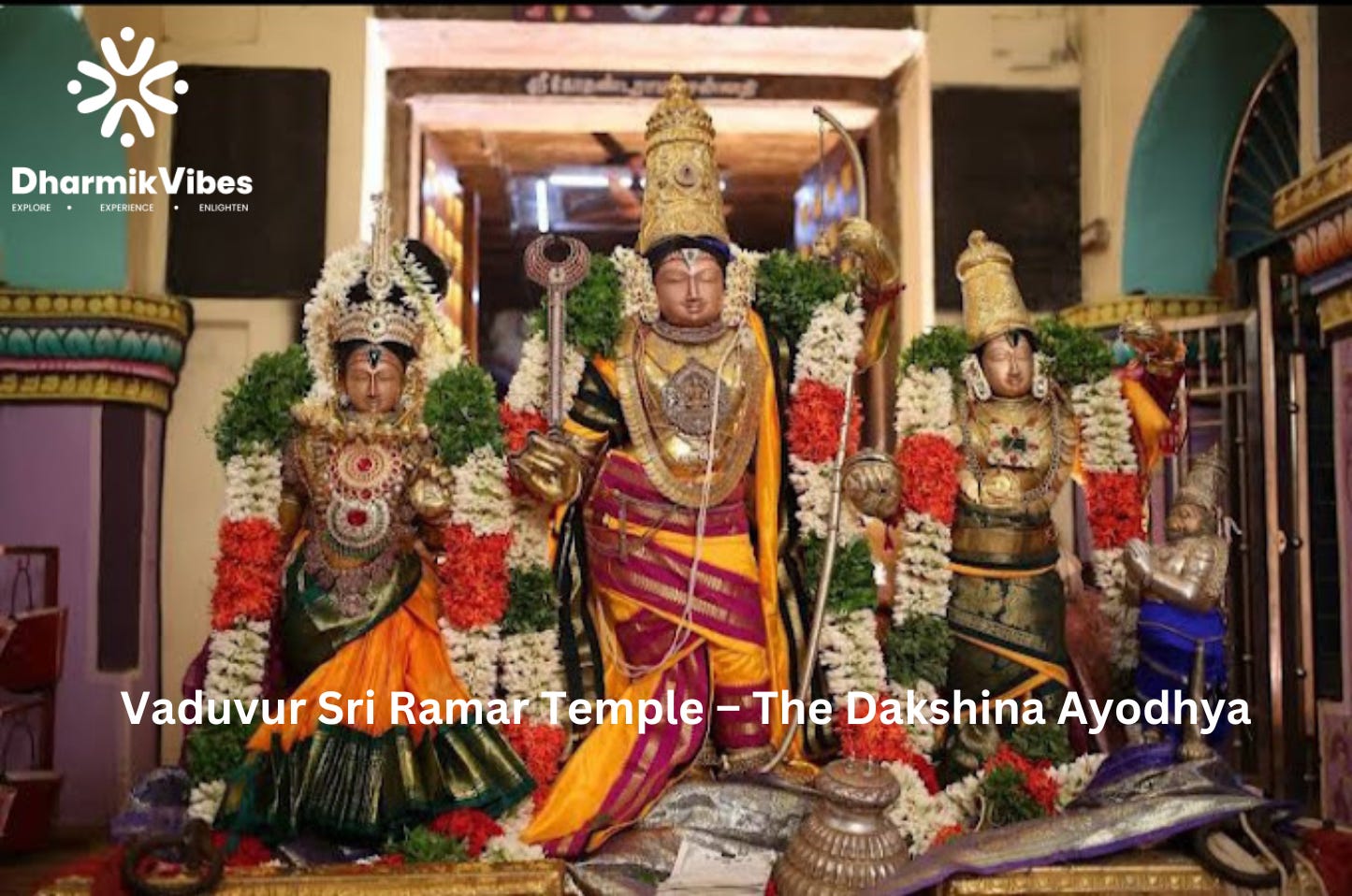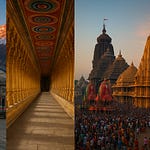Tucked away in the serene village of Vaduvur, near Thanjavur in the southern state of Tamil Nadu, lies one of the most revered Rama temples of India — the Vaduvur Sri Ramar Temple, also known as Dakshina Ayodhya. It is not just a temple but a spiritual haven that encapsulates the divine presence of Lord Sri Rama, Sita Devi, Lakshmana, and Hanuman. Known for its architectural elegance and devotional depth, this temple is a significant destination for devotees of Sri Rama and followers of the Vaishnavite tradition.
🛕 Temple Origin and Mythological Backdrop
The origins of the Vaduvur Sri Ramar Temple are steeped in legend and devotion. It is believed that the idol of Lord Rama enshrined in the temple was originally found in a forest area by a sage. According to popular lore, the temple deity was recovered from the nearby Pullambadi forest after a divine dream of a devotee or king (depending on oral traditions). The idol was then consecrated in Vaduvur under divine guidance, making the temple a focal point of Sri Rama’s worship in southern India.
The temple was built and nourished under the patronage of kings from the Thanjavur Maratha dynasty and local rulers, who ensured its upkeep and significance in the region. Over time, the temple gained immense religious importance, drawing comparisons to Ayodhya, the birthplace of Sri Rama.
Hence, Vaduvur earned the divine title: Dakshina Ayodhya — The Southern Ayodhya.
🌸 The Deity: Lord Sri Kodandaramar
The main deity here is Sri Kodandaramar, depicted with his bow (Kodanda) in hand, standing majestically with his consort Sita Devi, his loyal brother Lakshmana, and the eternal devotee Hanuman. The image of Lord Rama here exudes peace, protection, and unwavering dharma.
Unlike many other Rama temples, the focus on Kodandaramar — the warrior form of Rama — signifies divine strength balanced by compassion and justice. The deity’s form is deeply revered for granting peace of mind, family harmony, success in righteous ventures, and protection from adversities.
📜 Historical Significance
The temple is recognized as one of the 108 Abhimana Sthalams — sacred Vaishnavite temples not included in the 108 Divya Desams but still highly venerated.
It has served as a key spiritual center for Vaishnavism in the Tamil region, maintaining Pancharatra Agama traditions in worship.
The temple architecture reflects a beautiful mix of Chola and Nayak styles, with a tall Rajagopuram, exquisitely sculpted pillars, and an ornate Garbhagriha (sanctum sanctorum).
🔱 Religious Essence and Theological Importance
The Vaduvur temple is more than just a place of worship — it is a living embodiment of the Ramayana. Each day, devotees experience the divine story unfold in the rituals and darshans.
Key Themes Associated with the Temple:
Dharma (righteousness): Emphasizing the importance of truth, justice, and values, as upheld by Sri Rama.
Devotion (Bhakti): Seen in the presence of Hanuman at the lord’s feet, inspiring humility and service.
Family harmony: Represented by the divine presence of Sita and Lakshmana.
Victory over evil: As Lord Rama stands with his Kodanda, he embodies protection and courage.
🪔 Puja, Rituals & Aarti
🧘♂️ Daily Sevas and Pujas:
The temple follows a structured daily routine with traditional Pancharatra rituals, involving:
Suprabhatam (early morning awakening of the deity)
Alankaram (decoration)
Naivedyam (offering of food)
Deepa Aradhana (lamp worship)
Vishesha Archana (special chanting and pooja)
🔔 Aarti Timings:
Ushat Kalam (Morning Aarti): 6:00 AM – 7:00 AM
Kalasanthi Aarti: 8:00 AM – 9:00 AM
Sayaraksha Aarti (Evening): 6:00 PM – 7:30 PM
Arthajama Aarti (Night): 8:30 PM – 9:00 PM
🌺 Special Offerings:
Tulsi Archana and Rama Pattabhishekam Seva
Sahasranama Archana (1000 Names of Rama)
Sugreeva Vahana Seva on festival days
🎉 Festivals Celebrated
The temple is renowned for its grand celebration of Sri Rama Navami, which draws devotees from across Tamil Nadu and other states.
Major Festivals:
Sri Rama Navami Brahmotsavam (March–April)
Vaikunta Ekadashi (December–January)
Hanuman Jayanti
Navaratri and Deepavali with special alankarams
Monthly Punarvasu Star Days are also considered highly auspicious (as Rama was born on Punarvasu nakshatra)
🛣️ How to Reach Vaduvur Sri Ramar Temple
📍 Location:
Vaduvur village is situated in the Tiruvarur district of Tamil Nadu, between Thanjavur and Mannargudi.
🚆 By Train:
Nearest railway station: Mannargudi (8 km)
Well-connected from Thanjavur, Trichy, and Chennai
🚌 By Road:
Direct buses and taxis are available from Thanjavur, Tiruvarur, and Kumbakonam.
✈️ By Air:
Nearest airport: Tiruchirappalli International Airport (TRZ) – 90 km away
🏨 Accommodation Options
There are small guest houses and dharmashalas available near the temple for pilgrims. Nearby towns like Thanjavur and Mannargudi have hotels ranging from budget to mid-tier for comfortable stays.
📸 Visitor Tips & Travel Insights
Best time to visit: October to April, to avoid summer heat and coincide with temple festivals.
Dress modestly in traditional attire for entry into sanctum areas.
Participate in the morning or evening aarti for a spiritually uplifting experience.
Don’t miss the Pushkarini (temple tank) and beautiful temple corridors filled with mural paintings and sculptures of Ramayana stories.
✨ A Temple of Devotion and Dharma
The Vaduvur Sri Ramar Temple is not just a sacred site — it is a living epic of Sri Rama’s life, dharma, and divinity. Whether you are a pilgrim, a spiritual seeker, a history enthusiast, or a traveler in search of peace, this temple offers a deep emotional and spiritual connection.
In a world driven by chaos, the calm gaze of Kodandaramar reminds us of resilience, righteousness, and divine protection. Truly, this temple stands tall as the Dakshina Ayodhya, where the heart of Rama continues to beat in the soul of South India.











